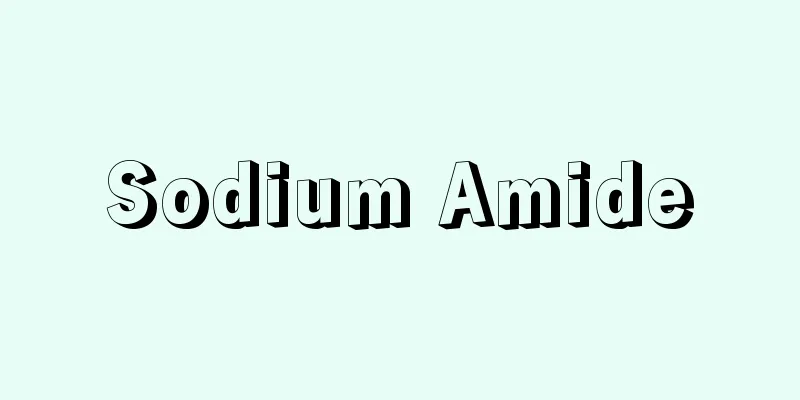Refractories

|
This refers to materials that can withstand extremely high temperatures when used for lining kilns or other places exposed to severe heat. High temperatures are generally 1500°C or higher. JIS (Japanese Industrial Standards) sets the lower limit of temperatures at SK26 (1580°C), and specifies that anything with a fire resistance above this level is refractory. As industry advances, refractories are required to have not only fire resistance, but also load-bearing capacity at high temperatures, thermal shock resistance, heat transfer, resistance to oxidizing and reducing atmospheres, acidic and basic slag, slag adhesion, slag penetration, mechanical abrasion resistance, and electrical resistance at high temperatures. [Yoichi Motoki] ClassificationRefractories can be classified by (1) chemical and mineralogy, (2) fire resistance, and (3) manufacturing method. In terms of chemistry and mineralogy, they are generally divided into three groups: acidic, basic, and neutral. In terms of manufacturing method, they can be classified into (1) molded bricks and blocks (electrocast refractories, fired refractories, and unfired refractories), (2) irregular bodies (stamped materials, sprayed and smeared materials, cast bodies, and mortars), and (3) natural stones. [Yoichi Motoki] Refractory properties and applicationsRefractories include heavy or coarse-grained products and fine-grained products used for special purposes, but the former are generally classified as refractories and the latter as fine ceramics. The characteristics and main uses of refractories made from each mineral as the main component are as follows: [Yoichi Motoki] Silica RefractoriesIt can withstand a load of 3.5 kilograms per square centimeter at temperatures up to 1710°C, and can be safely used in structures up to 1650°C. It does not shrink until its melting temperature, and has high thermal shock resistance in the range of 600-1700°C. It is highly resistant to corrosion by fluxes and acid slag, which are the main components of steelmaking furnaces, and is also highly resistant to abrasion. It is easily attacked by basic slag and fluorine. It has high thermal conductivity at high temperatures. Its only serious drawback is its sensitivity to thermal shock below 600°C, and below 300°C when fully fired. Due to these properties, it is used for (1) walls, roofs, hearths, etc. of acid open hearth steelmaking furnaces, (2) coke oven bodies, gas generators, etc., and (3) glass tank kilns, flues, and cart blocks for tunnel kilns, etc. [Yoichi Motoki] Aluminosilicate refractoriesGenerally known as chamotte bricks. Their characteristics depend largely on the type and properties of the clay and chamotte used, or the refractory raw materials that replace the chamotte. In Japan, they are classified into nine types based on their characteristics. Their applications are extremely wide, including blast furnace bricks, hot air stove bricks, coke oven bricks, essential materials for steelmaking, the glass and enamel industries, the transportation industry, metal melting furnaces, annealing kilns, gas generators, cement firing kilns, ceramic firing kilns, chemical industry furnaces, and glass tank kilns. [Yoichi Motoki] MulliteIt can withstand high temperatures up to 1830℃, has high resistance to molten slag and glass, and has excellent thermal shock resistance. It is widely used in glass tank kilns, burner blocks, frit kilns, ceramic firing kiln setter tiles, electric arc furnace ceilings, and other applications. [Yoichi Motoki] Alumina or CorundumExtremely resistant to oxidation and reduction, slag and mechanical wear up to 1900°C, high refractoriness, resistance to load softening and good heat transfer. Resistant to basic slag, high electrical resistance at high temperatures. Low resistance to spalling, adhesion and penetration by slag. Used in ceramic and enamel kiln muffles, burner blocks, hot gas or heavy oil kilns, etc. [Yoichi Motoki] Stabilized ZirconiaAcid refractory for use in acidic conditions up to 2400 °C. Small evaporation at high temperatures. Good thermal shock resistance. Safe in contact with 50-90% alumina, chromium, chromium-magnesia, forsterite, magnesia and silica up to 1600 °C. Safe against high alumina refractories up to 1550 °C and zircon refractories up to 1900 °C. Decomposes at about 2200 °C in vacuum, hydrogen and nitrogen atmospheres. Low electrical resistance at high temperatures. Used for melting metals with acid slag if oxide formation can be avoided. Used for seamless furnace body construction, gas-fired kiln refractories up to 2000 °C, burner blocks, nozzles, glass feed blocks, high temperature insulation, high frequency induction furnaces for melting platinum at 1900 °C, nitrogen fixation devices up to 2315 °C. [Yoichi Motoki] ZirconNo crystal transformations, uniform thermal expansion. Good resistance to molten metals unless strongly oxidized. Resistant to borosilicate glass, metaphosphates, sodium chloride, sodium chloride-zinc chloride flux, potassium pyrophosphate, and phosphorus pentoxide. Attacked by sodium carbonate and sodium fluoride, fluorite, cryolite, molten barium sulfate, and pyrophosphate tetrasodium. Good resistance to thermal shock. Used in furnaces for remelting aluminum, phosphate-lime fertilizer furnaces, glass tank kilns, etc. [Yoichi Motoki] SergianIt is a highly basic refractory with high density, low expansion, high impact strength, and excellent resistance to molten aluminum and alkaline vapors. [Yoichi Motoki] carbonIt has high refractory properties, good volumetric stability, resistance to a wide range of chemicals, high strength at high temperatures, is not wetted by molten slag or iron, and has relatively high thermal conductivity. It oxidizes in air above 350 °C, reacts with water above 590 °C, and with carbon dioxide above 700 °C. Alkaline residues from blast furnaces begin to attack carbon bricks at 815 °C. Carbon is used in blocks for blast furnace hearths and glories, and in bricks for blast furnace stacks. It is made into tanks for runners and in ferroalloy furnaces. Other uses include boats for sintering tungsten carbide in carbon tube furnaces. [Yoichi Motoki] Silicon carbideIt has outstanding load-bearing capacity at room and high temperatures, high spalling resistance, good heat transfer, and resistance to reduction, acid slag, adhesion and penetration by slag, and mechanical wear. It has high refractoriness and is not easily oxidized outside the temperature range of 800-1200°C. It has very low electrical resistance at high temperatures. In addition, its reasonable price means that it is used in many applications, including slurry nozzles, spray nozzles, protective tubes, and wire guides, in addition to various kiln materials. [Yoichi Motoki] Magnesia RefractoriesA typical basic refractory with an erosion-resistant, sometimes very dense structure, very high refractoriness and high thermal conductivity. Very resistant to basic slag, but less resistant to high silica slag. Standard bricks have poor spalling resistance, but special molds, chemically bonded or metal-encased, have good spalling resistance. Used in the hearths and roofs of basic arc furnaces and open hearths, and in the back, front and end walls of steel furnaces. Linings of copper, tin, lead and antimony melting and refining furnaces, cement rotary kilns, glass melting kilns and lower side walls of soaking kilns. [Yoichi Motoki] Dolomite RefractoriesIt is a basic refractory material that is cheaper than magnesia, has low porosity, high compressive strength, high softening temperature under load, and a wide softening temperature range and volume stability range, but has very poor thermal shock resistance. It is used in open hearth furnaces, etc. [Yoichi Motoki] Chrome-magnesia and magnesia-chrome refractoriesIt has high mechanical strength and stability at high temperatures, excellent resistance to spalling, and high resistance to attack by basic slag. It has higher resistance to torsion and tension at high temperatures than magnesia. It has a tendency to burst when in contact with iron oxide. It is used in non-ferrous metallurgical furnaces, converters and reverberatory furnaces, and full basic open hearth furnaces. [Yoichi Motoki] Chrome RefractoriesIt has high resistance to erosion by basic and moderately acidic slags and fluxes. Basic slags generally do not stick to chrome bricks. It has a relatively low softening temperature under load and low thermal shock resistance. It is used in basic open hearth furnaces, intermediate stacking of magnesia and silica bricks, and in soda salt recovery furnaces in the paper industry. [Yoichi Motoki] "Yoichi Motoki, Ceramic Materials for Furnace Construction" (1973, Gihodo Publishing)" ▽ "JIS Handbook Refractories 2003" (2003), edited and published by the Japanese Standards Association [Reference item] |Source: Shogakukan Encyclopedia Nipponica About Encyclopedia Nipponica Information | Legend |
|
窯炉の内張りその他過酷な加熱にさらされる場所に用いたときに、相当の高温に耐えることのできる材料をいう。高温というのは一般に1500℃以上である。JIS(ジス)(日本工業規格)では温度の下限をSK26(1580℃)とし、これ以上の耐火度を有するものを耐火物と規定している。 工業の進歩に伴い、耐火物は単に耐火度ばかりではなく、高温における耐荷重能力、熱衝撃抵抗性、熱伝達性のほか、酸化および還元雰囲気、酸性および塩基性鉱滓(こうさい)、鉱滓粘着、鉱滓浸透、機械的摩耗に対する抵抗性、高温における電気抵抗性などが要求されている。 [素木洋一] 分類耐火物は、(1)化学的鉱物学的、(2)耐火度、(3)製造様式、で分類できる。化学的鉱物学的には酸性、塩基性、中性の3群に分けるのが一般的である。製造様式からは、〔1〕成形れんがとブロック(電鋳耐火物、焼成耐火物、不焼成耐火物)、〔2〕不定形素地(スタンプ材、吹付けと塗抹材、鋳込み素地、モルタル類)、〔3〕天然石、に分類される。 [素木洋一] 耐火物の特性と用途耐火物には重量物または粗粒からなる製品と、特殊作業に用いる微細粒子からなる製品とが入るが、一般には前者を耐火物に、後者をファイン・セラミックスに入れる。それぞれの鉱物を主成分としてつくられた耐火物の特性と主用途は次のようである。 [素木洋一] 珪石耐火物1710℃の温度以内で1平方センチメートル当り3.5キログラムの荷重に耐えることができ、構造物としては1650℃まで安全に使用できる。その熔融(ようゆう)温度に至るまでは収縮を示さず、600~1700℃の範囲では熱衝撃抵抗性が大きい。製鋼炉の主体になる融剤および酸性鉱滓の侵食に対する抵抗性が大きく、摩耗に対する抵抗性も大きい。塩基性鉱滓およびフッ素には容易に侵食される。高温における熱伝導度が大きい。唯一の重大な欠点は600℃以下、十分に焼成されたものでは300℃以下の熱衝撃に敏感なことである。このような性質があるため、〔1〕製鋼用酸性平炉の壁、天井、炉底など、〔2〕コークス炉炉体、ガス発生炉など、〔3〕ガラス槽窯用と煙道、トンネル窯の台車用ブロック、などに利用される。 [素木洋一] アルミノ珪酸塩耐火物一般にシャモットれんがという。特性は、使用する粘土およびシャモットあるいはシャモットを置換する耐火原料の種類や性質に大きく左右される。日本ではその特性によって9種類に区分する。用途は非常に広く、高炉れんが、熱風炉れんが、コークス炉れんが、製鋼用必需材料、ガラスおよびほうろう工業用、交通工業用、金属熔解炉、徐冷窯、ガス発生炉、セメント焼成窯、陶磁器焼成窯、化学工業用炉、ガラス槽窯などに用いられている。 [素木洋一] ムライト1830℃までの高温に耐え、熔融鉱滓およびガラスに対する抵抗性が大きく、熱衝撃抵抗性に優れている。ガラス槽窯、バーナー・ブロック、フリット窯、セラミック焼成窯のセッター・タイル、電弧炉天井、その他用途は広い。 [素木洋一] アルミナまたはコランダム1900℃までは酸化と還元、鉱滓および機械的摩耗に対する抵抗性がきわめて大きく、高耐火性、荷重軟化抵抗性と熱伝達性が大きい。塩基性鉱滓に対する抵抗性があり、高温で電気抵抗が大きい。スポーリング、鉱滓の粘着および浸透に対する抵抗性は小さい。セラミックスおよびほうろう用の窯のマッフル、バーナー・ブロック、高温ガスまたは重油窯などに用いる。 [素木洋一] 安定化ジルコニア酸性状態で2400℃まで使用できる酸性耐火物。高温での蒸発は小さい。熱衝撃抵抗性は良好。50~90%アルミナ、クロム、クロム‐マグネシア、フォルステライト、マグネシアおよびシリカと接触していても1600℃までは安全。高アルミナ耐火物に対しては1550℃まで、ジルコン耐火物とは1900℃まで安全である。真空中、水素および窒素雰囲気中では約2200℃で分解する。高温度では電気抵抗は低い。酸化物の生成が避けられるならば酸性鉱滓の混じった金属の熔融に用いられる。継目なし炉体構築用、2000℃までのガス焼成窯用耐火物、バーナー・ブロック、ノズル、ガラス供給用ブロック、高温断熱材、1900℃で白金を熔融する高周波誘導炉、2315℃までの窒素固定装置などに使用される。 [素木洋一] ジルコン結晶の変態はなく、均一な熱膨張を示す。強酸化状態でない限り熔融金属に対する抵抗性は良好。ホウケイ(硼珪)酸ガラス、メタリン酸塩、塩化ソーダ、塩化ソーダ‐塩化亜鉛融剤、焦性リン酸カリ、五酸化リンに対して抵抗性をもつ。炭酸ソーダとフッ化ソーダ、蛍石、氷晶石、熔融硫酸バリウム、および焦性リン酸四ソーダに侵食される。熱衝撃抵抗性は良好。アルミニウム再熔融用炉、リン酸石灰肥料用炉、ガラス槽窯などに用いる。 [素木洋一] セルジアン高密度、低膨張、高衝撃強度、熔融アルミニウムおよびアルカリ蒸気に対しきわめて抵抗性の大きな高塩基性耐火物である。 [素木洋一] 炭素高耐火性で容積安定性が良好、広範囲にわたって化学薬品に対して抵抗性があり、高温でも強度が大きく、熔融鉱滓または鉄に濡(ぬ)れず、熱伝導度は比較的高い。空気中では350℃以上で酸化し、水とは590℃以上、炭酸ガスとは700℃以上で反応する。熔鉱炉からのアルカリ性残渣(ざんさ)は815℃で炭素れんがを侵食し始める。炭素はブロックでは高炉炉床および朝顔に、れんがは熔鉱炉のスタックに使用される。槽につくったものは湯道に、また合金鉄炉に用いられる。そのほか、炭素管炉内で炭化タングステン焼結用のボートなどの用途がある。 [素木洋一] 炭化ケイ素室温および高温における耐荷重性に著しく優れ、耐スポーリング性が大きく、熱伝達性がよく、還元、酸性鉱滓、鉱滓の粘着および浸透、機械的摩耗に対して抵抗性がある。耐火度が高く、800~1200℃の温度範囲以外では酸化しにくい。高温における電気抵抗は非常に小さい。そのうえ価格も適当であるため、各種窯炉材料のほかスラリー・ノズル、スプレー・ノズル、保護管、ワイヤー・ガイドなど多くの用途がある。 [素木洋一] マグネシア耐火物耐侵食性で、ときに非常に緻密(ちみつ)な組織の代表的な塩基性耐火物で、耐火度がきわめて高く、また熱伝導度が大きい。塩基性鉱滓に対しては抵抗性が非常に大きいが、シリカ含有量の多い鉱滓に対しては抵抗性は小さい。標準れんがはスポーリング抵抗性は悪いが、特殊な型で化学結合あるいはメタルケースにしたものは良好である。塩基性アーク炉と平炉の炉床および天井、製鋼炉の後壁、前壁、突当り壁に用いる。銅、錫(すず)、鉛、アンチモンの熔融炉および精澄炉の内張り、セメント回転炉、ガラス熔融窯、均熱炉の下部側壁に使用する。 [素木洋一] ドロマイト耐火物マグネシアよりも安価で、低気孔率、高耐圧強度、荷重軟化温度が高く、軟化温度範囲および容積安定範囲は広いが、熱衝撃抵抗性は非常に劣る塩基性耐火物である。平炉などに用いる。 [素木洋一] クロム‐マグネシアおよびマグネシア‐クロム耐火物高温における機械的強度と安定性が大きく、耐スポーリング抵抗性に卓越、塩基性鉱滓による侵食には大きな抵抗性をもつ。高温におけるねじりおよび引張りに対する抵抗性はマグネシアよりも強い。酸化鉄と接触するとバースティングの傾向をもつ。非鉄金属冶金(やきん)炉、転炉および反射熔融炉、全塩基性平炉などに使用される。 [素木洋一] クロム耐火物塩基性および中程度の酸性鉱滓および融剤に対する耐侵食抵抗性が大きい。一般的にみて塩基性鉱滓はクロムれんがに粘着しない。荷重軟化温度は比較的低く、熱衝撃抵抗性は小さい。塩基性平炉やマグネシアれんがと珪石れんがの中間積(づみ)に用い、製紙工業におけるソーダ塩回収炉に使用する。 [素木洋一] 『素木洋一著『築炉用セラミック材料』(1973・技報堂出版)』▽『日本規格協会編・刊『JISハンドブック 耐火物2003』(2003)』 [参照項目] |出典 小学館 日本大百科全書(ニッポニカ)日本大百科全書(ニッポニカ)について 情報 | 凡例 |
<<: Payment of the price - Daikabensai
Recommend
Kinesis (English spelling)
Orthokinesis is a type of movement in which the bo...
Tonden - Tonden
〘Noun〙① Before the Ritsuryo system, the fields wer...
Merger - Gappei
When two or more companies become one company thr...
Cube - Rippoutai (English spelling) cube
A regular polyhedron with six square faces. Also c...
Apia - Apia (English spelling)
It is the capital of Samoa (formerly Western Samo...
Didacus
…Born into a noble family in Castile, Spain, he s...
Attached organisms - Fuchakuseibutsu
A general term for organisms that live by attachin...
Tights (English spelling)
A stretchy leg garment that tightly envelops the s...
Hesperornis
…Archaeopteryx [Appearance of new birds] No bird ...
Taraxacum laevigatum
…[Yoshiharu Iijima]. … *Some of the terminology t...
Gandharva Music
...The emotions that form the basis of artistic e...
Cologne (English spelling)
Cologne in English and French. Located on the left...
Boulder Dam
…A gravity arch dam was completed in 1935 in the ...
Joints
In the skeleton of an animal, the bones are conne...
Wise
〘Noun〙 Old name for the plant "gaimo (rush)&q...









